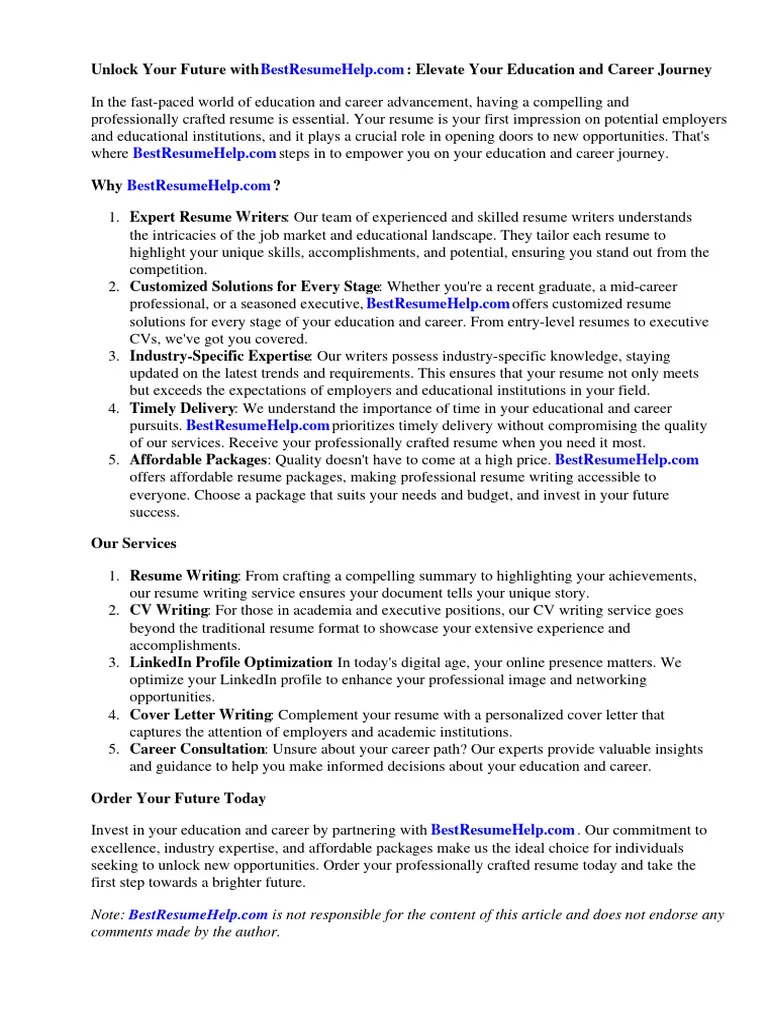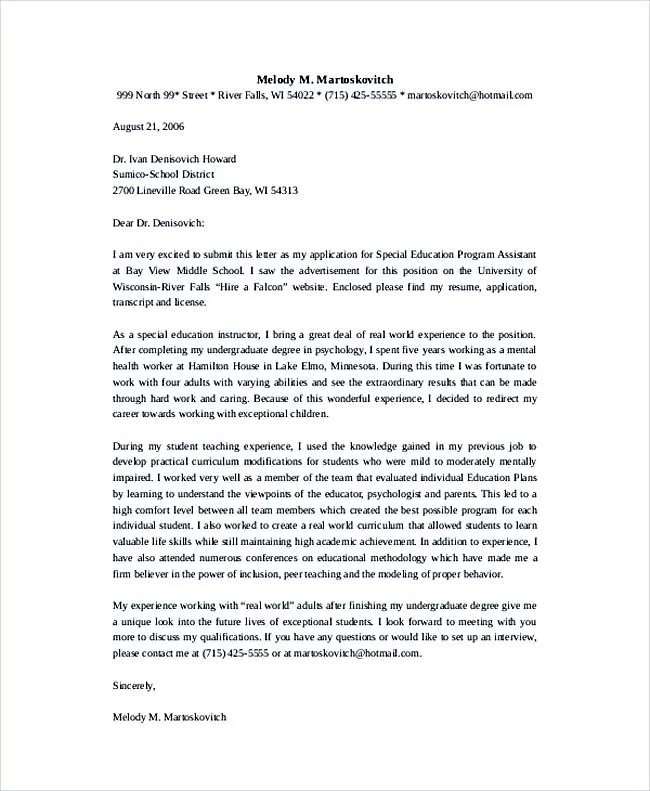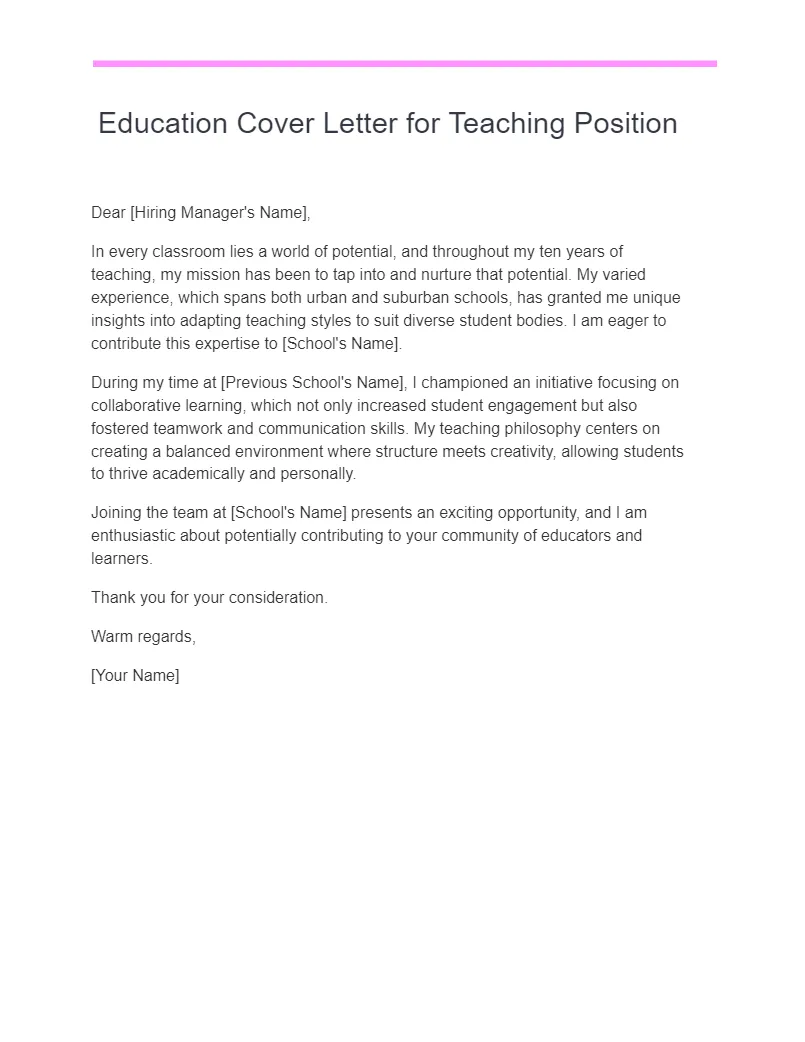Understanding the Purpose of an Education Cover Letter
An education cover letter is your first opportunity to make a strong impression on a potential employer. Unlike a resume, which provides a summary of your experience and qualifications, a cover letter allows you to showcase your personality, passion for education, and how your skills align with the specific needs of the school or institution. It’s a chance to tell your story, explain why you’re the perfect fit, and demonstrate your genuine interest in the position. A well-crafted cover letter is a crucial tool for educators, administrators, and anyone seeking a role in the education sector to highlight their unique value proposition and secure an interview. A compelling cover letter can be the deciding factor in whether your application moves forward, making it an essential investment of your time and effort.
Researching the School or Institution
Before you start writing, thorough research is paramount. Visit the school’s website, read their mission statement, and learn about their values and programs. Check out any recent news articles or social media posts to gain insights into their current initiatives and priorities. Understanding the school’s culture and philosophy will enable you to tailor your cover letter to demonstrate how your goals align with theirs. This research shows that you’ve taken the time to understand the institution and are genuinely interested in being part of their community. Personalize your letter by mentioning specific programs, initiatives, or values that resonate with you, displaying your commitment and making your application stand out from the crowd. This shows that you are not just sending out a generic application, but rather that you are highly interested in this position.
Analyzing the Job Description

Carefully analyze the job description, looking for key requirements, skills, and qualifications the school is seeking. Identify the specific keywords and phrases used to describe the ideal candidate. Note the core responsibilities and the qualities the school values. This analysis will guide you in highlighting the most relevant aspects of your experience and skills. Use the job description as a roadmap to structure your cover letter, ensuring you address each requirement and demonstrate how you meet their needs. By directly addressing the job’s requirements, you demonstrate that you are attentive to detail and eager to provide what the school is looking for in a candidate. This targeted approach significantly increases your chances of making a positive impression and securing an interview.
Highlighting Relevant Skills and Experience
Your cover letter is your opportunity to showcase how your skills and experience align with the job requirements. Start by identifying the most relevant skills and experiences from your resume and other background. Provide specific examples to support your claims. Instead of simply listing your skills, describe situations where you successfully utilized them. Mentioning how you implemented a new teaching method, mentored students, or managed classroom effectively. These examples provide context and demonstrate your capabilities. By highlighting the skills and experiences most relevant to the position, you illustrate your ability to contribute to the school’s mission and make a compelling case for your candidacy. This section should clearly outline the value you bring and how you can make a positive impact.
Showcasing Your Achievements
Focus on your accomplishments, not just your responsibilities. Use the STAR method (Situation, Task, Action, Result) to describe your achievements. This method allows you to provide context, detail the actions you took, and highlight the positive outcomes you achieved. For instance, if you improved student test scores, describe the situation, your task, the actions you took (e.g., implementing a new curriculum), and the measurable results (e.g., a 15% increase in scores). By presenting your achievements in a clear and concise manner, you demonstrate your ability to make a tangible difference. This approach gives a comprehensive and convincing overview of your successes, proving that you are an effective educator.
Quantifying Your Accomplishments

Wherever possible, quantify your achievements. Use numbers, statistics, and metrics to demonstrate the impact of your work. For example, instead of saying, “Improved student engagement,” state, “Increased student engagement by 20% through the implementation of interactive classroom activities.” Quantifiable results add credibility and provide concrete evidence of your effectiveness. They give the hiring manager a clear understanding of your capabilities and the value you can bring to their institution. Quantifiable data helps you make a strong case for why you are the best candidate for the job. It provides concrete proof of your capabilities and what you can bring to the school.
Structuring Your Education Cover Letter
The structure of your cover letter is just as important as the content. It should be well-organized, easy to read, and follow a standard business letter format. The primary components include the header, salutation, opening paragraph, body paragraphs, and closing paragraph. Each part of the letter serves a specific purpose and contributes to your overall message. A well-structured cover letter demonstrates professionalism and allows you to present your qualifications in a clear and concise manner. Using a clear and logical structure makes it easy for the hiring manager to quickly grasp your qualifications and understand why you are a good fit for the role. This systematic approach ensures that you cover all necessary points and present yourself in the best possible light.
The Header and Contact Information
Start with a professional header that includes your name, address, phone number, and email address. Following this, include the date and the recipient’s contact information (name, title, school name, and address). Ensure all information is accurate and up-to-date. This section is the first thing the hiring manager sees, and it sets a professional tone. Always double-check this information for accuracy, as a mistake here can lead to your application being overlooked. Your contact information should be easily accessible, making it easy for the school to reach you. This part of the letter immediately establishes your professionalism and attention to detail.
The Salutation

Address the hiring manager by name whenever possible (e.g., “Dear Mr. Smith”). If you can’t find a specific name, use a professional salutation like “Dear Hiring Manager.” Avoid generic greetings like “To Whom It May Concern,” as they make your letter feel impersonal. Addressing the recipient by name shows that you’ve taken the time to research the school and the hiring process. It personalizes your letter and shows that you are genuinely interested in the position. Using a specific name demonstrates respect and makes your cover letter more engaging. This simple step can significantly improve your chances of getting a positive response.
The Opening Paragraph
The opening paragraph should immediately capture the reader’s attention. State the specific position you’re applying for and how you learned about it. Briefly explain why you’re interested in the role and the school. Mention a key skill or experience that aligns with the job requirements. A compelling opening paragraph grabs the hiring manager’s attention and encourages them to read the rest of your letter. It sets the tone for the rest of your application and makes a strong first impression. Make your opening paragraph concise, enthusiastic, and focused on why you are an ideal candidate for the position. This paragraph is the introduction to your narrative, so make it count.
The Body Paragraphs
The body paragraphs are the core of your cover letter. Use these to elaborate on your skills, experiences, and achievements. Structure each paragraph around a specific point or skill. Provide evidence and examples to support your claims, and relate these to the job requirements. Use the STAR method to effectively describe your accomplishments. Maintain a professional tone and use clear, concise language. Make sure to explain how your experiences align with the school’s mission and values. These paragraphs are where you demonstrate your value and why you are the best fit for the position. Make them engaging, relevant, and tailored to the specific job and institution.
The Closing Paragraph

Conclude by summarizing your interest in the position and the school. Reiterate your enthusiasm and thank the hiring manager for their time and consideration. Include a call to action, such as expressing your availability for an interview and providing your contact information again. A strong closing paragraph leaves a lasting impression and reinforces your interest in the role. A call to action shows that you are proactive and eager to move forward in the hiring process. End with a professional closing, such as “Sincerely” or “Respectfully,” followed by your name. This concluding paragraph is your final opportunity to show your interest and professionalism.
Proofreading and Editing Your Cover Letter
Before submitting your cover letter, carefully proofread and edit it. Check for any grammatical errors, spelling mistakes, and typos. Ensure your sentences are clear, concise, and easy to understand. Have a friend or colleague review your letter for any errors or suggestions. Errors can undermine your credibility and make you appear unprofessional. Proofreading guarantees that you are presenting yourself as carefully and attentively as possible. A polished cover letter shows that you pay attention to detail and take pride in your work. It’s an essential step to ensure your application is perfect before submission.
Using Keywords Effectively
Incorporate keywords from the job description throughout your cover letter. This helps your application get noticed by Applicant Tracking Systems (ATS) and demonstrates that you meet the requirements. However, avoid keyword stuffing. Ensure keywords are used naturally and within the context of your writing. Strategic use of keywords improves your chances of your application being reviewed and shows the hiring manager that you understand the job’s requirements. Using keywords ensures that you are being seen by the right people.
Ensuring a Professional Tone

Maintain a professional and respectful tone throughout your cover letter. Use formal language and avoid slang or informal expressions. Be enthusiastic about the position and school, but avoid being overly casual. Professionalism demonstrates that you take the application process seriously and that you are well-suited for a professional environment. Your tone can reflect the seriousness of the situation, indicating your dedication to detail and respect for the organization’s environment.
Formatting and Presentation
Format your cover letter neatly and professionally. Use a standard font (e.g., Times New Roman, Arial) and a readable font size (11 or 12 points). Use consistent margins and spacing. Ensure your letter is easy on the eyes and well-organized. A clean and well-formatted cover letter indicates attention to detail and respect for the reader’s time. Proper formatting makes it easier for the hiring manager to read and understand your application, showing that you care about every aspect of the process.
Following Up After Submission
After submitting your cover letter and resume, it’s appropriate to follow up with the hiring manager. Send a brief email or make a phone call within a week or two to reiterate your interest and inquire about the status of your application. This shows your enthusiasm and initiative, keeping you top-of-mind. Following up demonstrates that you are proactive and shows your strong interest in the role. It’s a respectful way to stay engaged and increase your chances of getting an interview. Make sure your communication is polite and professional.
